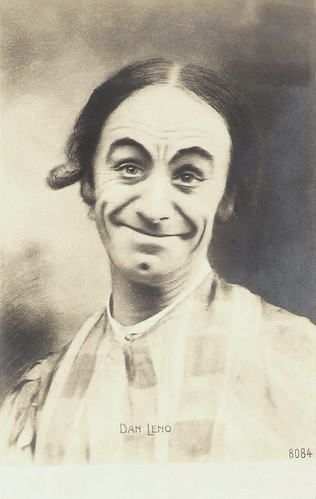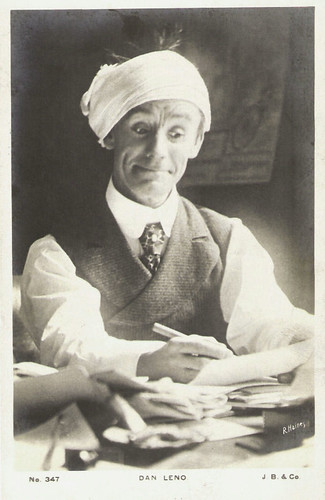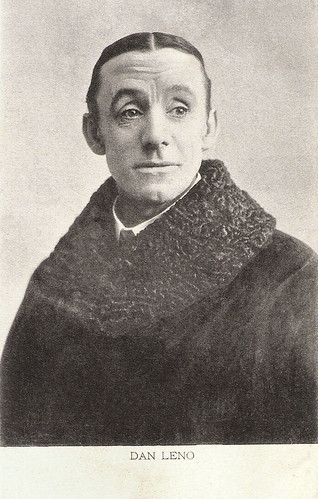
Small British postcard in the Midget postcard Series by Rotary Photo EC., no. 6317. Photo: Langfier, Glasgow.
One of the highest-paid comedians in the world
Dan Leno was born George Wild Galvin in St Pancras, London, in 1890. He was the youngest of six children. His parents, John Galvin and his wife Louisa, née Dutton, performed together in a music hall double act called ‘The Singing and Acting Duettists’. They were not very successful, and the family struggled in poverty.
In 1864, at the age of four, George joined his parents on stage in their music hall act, billed as 'Little George, the Infant Wonder, Contortionist, and Posturer'. That same year, his father, an alcoholic, died at the age of 37. The family moved to Liverpool a few months later, where his mother married the comedian William Grant, a.k.a. William Leno.
In 1865, George and his brother, Henry, formed a clog dancing double act known as ‘The Great Little Lenos’. Tired of surviving on little or no money, Henry left the clog dancing act to take up a trade in London, forcing Leno to consider a future as a solo performer. He made his first solo appearance, aged nine, at the Britannia Music Hall in Coventry. In his teen years, he became the star of his family's act. Leno's clog dancing continued to be so good that in 1880, he won the world championship at the Princess's Music Hall in Leeds and won a silver belt. The judges sat under the stage and listened to the beats.
He adopted the stage name Dan Leno and, in 1884, made his first performance under that name in London. That year, he married Lydia Reynolds, a young dancer and comedy singer. As a solo artist, he became increasingly popular during the late 1880s and 1890s, when he was one of the highest-paid comedians in the world. He developed a music hall act of talking about life's mundane subjects, mixed with comic songs and surreal observations, and created a host of mostly working-class characters to illustrate his stories.
In 1886, Leno played the dame in 'Jack and the Beanstalk' at the Surrey Theatre. Such was his success that Augustus Harris hired him as dame at Drury Lane for the 1888 production of 'Babes in the Wood'. He became one of the greatest and most popular of all pantomime dames and continued to play during the Christmas season at Drury Lane for the next 15 years.

British postcard by Rotary photo, no. 139C. Photo: Davey Photo. Leno in costume as Sister Ann(e) in the pantomime 'Bluebeard' (1901) by J. Hickory Wood and Arthur Collins. Leno starred opposite Herbert Campbell's Bluebeard.

British postcard by Rotophot, no. 8084. Photo: Davey, Islington.
The king's jester
The highly paid Dan Leno was generous and active in charitable causes, especially to benefit performers in need. He continued to appear in musical comedies and his own music hall routines until 1902, although he suffered increasingly from alcoholism. This, together with his long association with dame and low comedy roles, prevented him from being taken seriously as a dramatic actor, and he was turned down for Shakespearean roles.
Between 1901 and 1903, Leno recorded more than twenty-five songs and monologues on the Gramophone and Typewriter Company label. Towards the end of his life, he also made 14 short films distributed by the Warwick Trading Company or British Mutoscope & Biograph Company, including Dan Leno's Attempt to Master the Wheel (1900), An Obstinate Cork (1902), and Dessert at Dan Leno's House (1902). In these crude silent shorts he portrayed a bumbling buffoon who struggles to carry out everyday tasks, such as riding a bicycle or opening a bottle of champagne.
In 1901, Leno, along with Seymour Hicks and his wife, the actress Ellaline Terriss, was invited to Sandringham House to take part in a Royal Command Performance to entertain King Edward VII, Queen Alexandra, their son George and his wife, Mary, the Prince and Princess of Wales. Leno performed a thirty-five minute solo act that included two of his best-known songs: ‘How to Buy a House’ and ‘The Huntsman’. As a memento, the king presented Leno with a jewel-encrusted royal tie pin, and thereafter, Leno became known as ‘the King's Jester’.
Leno was the first music hall performer to give a Royal Command Performance during the king's reign. Dan Leno had begun to drink heavily after performances, and, by 1901, like his father and stepfather before him, he had become an alcoholic. By 1902, he began to behave erratically and furiously, and he suffered a mental breakdown in early 1903. He was committed to a mental asylum but was discharged later that year.
After one more show, his health declined, and he died at his home in London in 1904, aged 43. His death and funeral were national news. The Daily Telegraph wrote in its obituary: "There was only one Dan. His methods were inimitable; his face was indeed his fortune ... Who has seen him in any of his disguises and has failed to laugh?" Dan and Lydia had five children. Their three youngest children – Ernest (1889), Sidney (1891) and May (1896) followed their father onto the stage. Sidney became known as Dan Leno Jr.

British postcard by J. Beagles & Co., London, no. 347. Photo: R. Haines.

British postcard in the Empire Series, London, no. 45.
Sources: Victoria and Albert Museum, Wikipedia and IMDb.
This post was last updated on 16 March 2025.
No comments:
Post a Comment